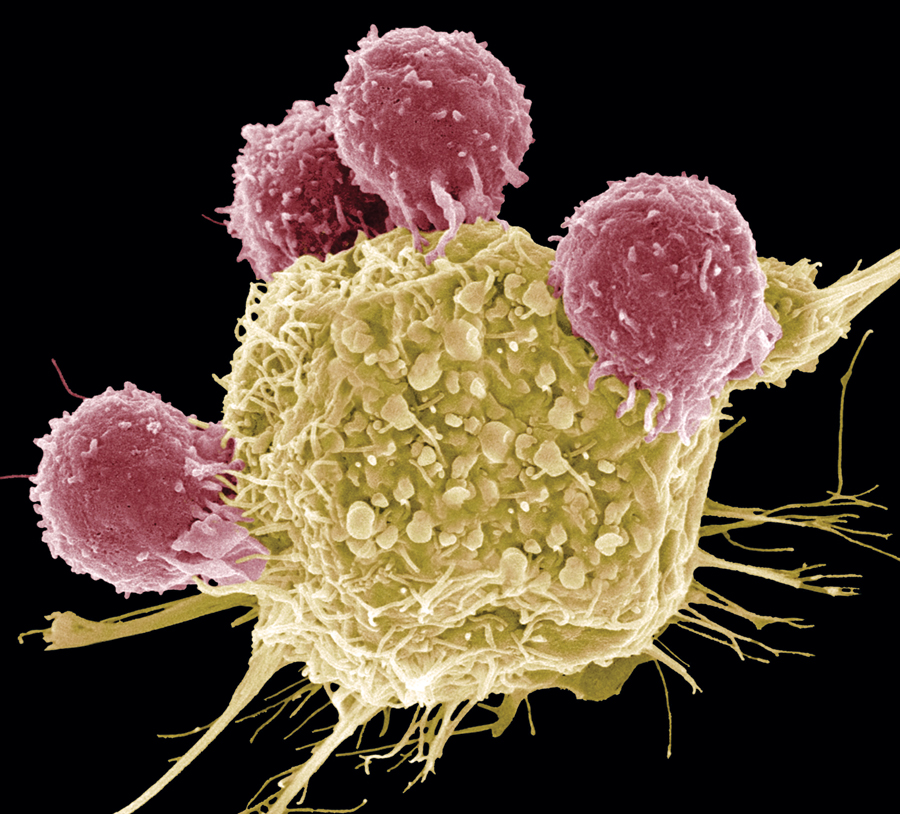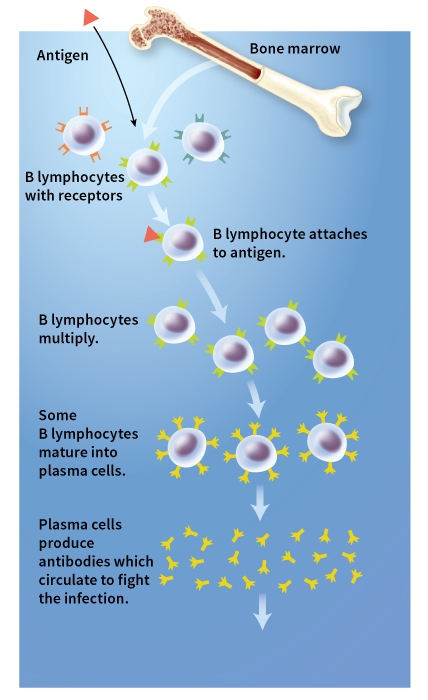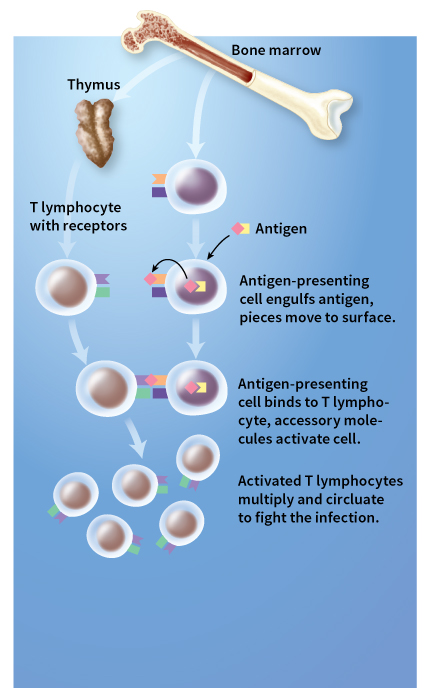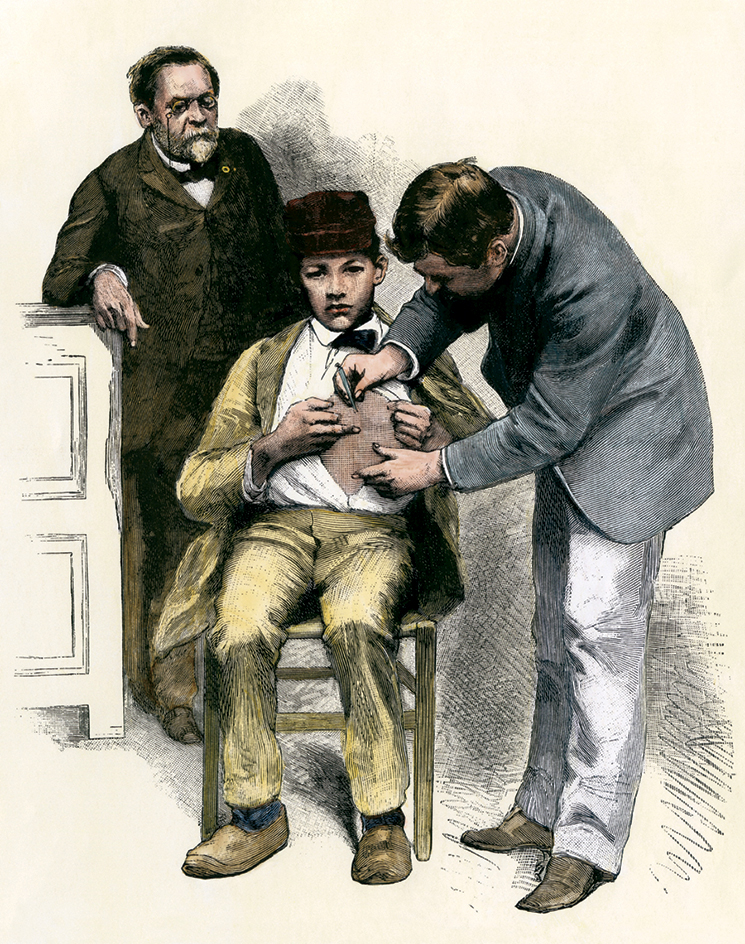Immune system is a combination of cells, proteins, and tissues that defend the body against disease and other harm. The immune system defends the body against harmful invaders, much as an army protects a country from attack. It provides protection against a variety of potentially damaging substances. These substances include disease-causing organisms, called pathogens. Common pathogens include bacteria, fungi, parasites, and viruses. The body’s ability to resist pathogens is called immunity.
The immune system reacts to foreign substances through a series of steps known as the immune response. Substances that trigger an immune response are called antigens (pronounced antigens << AN tuh juhnz >>).
Humans and other vertebrates (animals with backbones) have both innate immunity and acquired immunity. The innate (inborn) immune system, which is present in all animals, provides a generalized response to a wide range of invading pathogens. In many cases, white blood cells simply kill the pathogen by surrounding it and breaking it down. The innate immune system responds rapidly to infection. Acquired immunity develops in response to pathogens. It is also called adaptive or specific immunity because it adapts its attack to a particular pathogen. Unlike the innate immune system, the adaptive immune system can “learn” to fight a particular pathogen. Thus, it can provide lasting immunity against future infection.
Loading the player...How your immune system fights influenza
The immune system must recognize and destroy foreign invaders but spare the body’s own healthy tissues. Sometimes, however, the immune system wrongly identifies and attacks healthy tissues. This reaction is called an autoimmune response or autoimmunity.
The immune system cannot protect the body from all diseases by itself. Sometimes it needs help. Physicians give patients vaccines to help them develop protection against certain severe, life-threatening infections. Vaccines boost the body’s ability to defend itself against particular types of viruses or bacteria. The process of administering vaccines is known as immunization.
The scientific study of the immune system is called immunology. It dates from about the late 1800’s. Scientists who study the immune system are immunologists. At first, scientists knew little about how the immune system works. Today, immunologists are making great strides in their knowledge. Increasingly, scientists have turned laboratory discoveries about the immune system into medical treatments. Some of these treatments can help patients with disorders of the immune system.

Parts of the immune system
The immune system of humans and many other animals consists of numerous parts that work together. Chief among the parts are several types of cells, most of them white blood cells. They include lymphocytes << LIHM fuh sytz >> and antigen-presenting cells.
Lymphocytes
are special types of white blood cells. Like other white blood cells, lymphocytes originate in the bone marrow. The bone marrow is the blood-forming tissue in the center of many bones.
Some lymphocytes mature in the bone marrow. They become B lymphocytes, also known as B cells. The B stands for bone marrow derived. Some of these cells B cells develop into plasma cells, which produce antibodies. Antibodies are proteins that help other immune cells locate and destroy pathogens. Antibodies are carried in the blood, in tears, and in secretions of the nose and intestines. Antibodies are even passed from a mother to her newborn baby through the mother’s milk.
Other lymphocytes do not mature in the bone marrow. Instead, they travel through the bloodstream to the thymus. The thymus is an organ in the chest. There, the immature lymphocytes develop into T lymphocytes, also known as T cells. The T stands for thymus derived.

Large numbers of lymphocytes are stored in tissues called the primary lymphoid organs and secondary lymphoid organs. The primary lymphoid organs are the bone marrow and the thymus. They are the places where lymphocytes develop. Secondary lymphoid organs include the lymph nodes, the tonsils, and the spleen. Lymph nodes are small bean-shaped organs. There are hundreds of lymph nodes in the human body. They are bunched in certain areas, especially around the neck, armpits, and groin (where the thigh joins the abdomen). Lymph nodes filter out harmful particles and bacteria through a network of vessels called the lymphatic system. Lymph nodes may swell and become painful at times when the body is fighting an infection.
Antigen-presenting cells
surround foreign substances and digest them. This process is called phagocytosis << `fag` uh sy TOH sihs >>. During phagocytosis, antigen-presenting cells engulf foreign substances and break them up. After breaking the antigens into pieces, the antigen-presenting cells move the pieces to their surface. There, T cells may encounter and recognize the antigen fragments, which triggers an immune response. The process of exposing antigen pieces to T cells is called antigen presentation.
Many antigen-presenting cells are B lymphocytes. Two other types of white blood cells also serve as antigen-presenting cells. They are dendritic << dehn DRIHT ihk >> cells, and macrophages << MAK ruh fayj uhz >>. Dendritic cells have many long armlike projections. The cells occur throughout the body. But they collect in lymphoid tissues. Macrophages are large white blood cells that absorb invading organisms, harmful matter, and dead tissue. Macrophages are found throughout the body.
Other white blood cells
that help fight infections include eosinophils << `ee` uh SIHN uh fihlz >>, monocytes << MAHN uh syts >>, and neutrophils << NOO truh fihlz >>. These cells, like antigen-presenting cells, are phagocytes << FAG uh syts. >>. Phagocytes engulf and digest pathogens. Eosinophils play an important role in killing parasites. They are also associated with allergic reactions. Neutrophils fight mainly bacterial infections. When bacteria invade the body, neutrophils leave the bloodstream and travel to the infected area. Monocytes, like neutrophils, migrate to the site of infection. There they mature and become macrophages.
The immune response
There are two main forms of the immune response. They are the humoral immune response and the cell-mediated immune response. They differ mainly in the parts of the immune system involved. Many antigens trigger both forms of the immune response.
The humoral immune response
uses antibodies to fight infection. The word humoral refers to the bodily fluids that carry the antibodies. Antibodies are also known as immunoglobulins << ih `myoo` noh GLOB yuh lihnz >>. They are proteins produced by B lymphocytes and plasma cells. Antibodies help fight infection in several ways. For example, some antibodies coat antigens to make them more easily engulfed by macrophages and neutrophils. Antibodies also neutralize the effects of the toxins (poisons) secreted by some bacteria.
In some cases, the body produces enough antibodies to prevent symptoms from developing. In other cases, the body does not make enough antibodies to prevent symptoms, but the antibodies help the victim recover.
Some antibodies defend the body against infection by activating a group of proteins called complement. Complement is found in serum, the clear part of the blood. When activated, complement can assist in reactions that kill bacteria, viruses, or cells. For example, complement helps the process of phagocytosis. A bacterium is more effectively phagocytized if it is coated with both antibody and complement rather than with just one or the other. Complement proteins can also attract disease-fighting white blood cells to an area of infection.

Antibodies are highly specific. That means that each antibody acts effectively against only one particular antigen. For example, each type of influenza virus causes the body to produce a different antibody. The antibody that fights one flu virus may not work against another.
After the immune system has overcome an infection, lymphocytes called memory B cells “remember” the infection. This ability enables the immune system to respond rapidly if it meets the same type of antigen later.
People’s immune systems differ, largely due to heredity. As a result, individuals respond to antigens differently. For example, pollen has no effect on the immune systems of most people. But some people suffer the allergy known as hay fever, or allergic rhinitis. To them, pollen acts as an antigen. It triggers an immune response.
The cell-mediated immune response
occurs through the action of T lymphocytes and their chemical products. Like antibodies, T lymphocytes are highly specific. They respond only to particular antigens.

Two specialized proteins determine whether a T lymphocyte reacts to an antigen. They are the major histocompatibility complex (MHC) proteins and the T cell receptor proteins.
MHC proteins lie on the surface of almost all cells. They help the immune system identify the body’s own cells so they are not attacked.
T cell receptor proteins lie on the surface of T lymphocytes. During a cell-mediated immune response, T cell receptors on nearby T lymphocytes sample the antigen. They do this to determine if the T lymphocytes can bind to the antigen. T cell receptors fit only particular antigens, much as a key fits only certain locks. A proper fit sends the first signal to activate the T lymphocytes.
Activating the T lymphocytes also requires a second signal. This signal comes from accessory molecules on the surface of antigen-presenting cells and T cells. Only T lymphocytes that receive two proper signals—one from their T cell receptors and the other from their accessory molecules—will be activated. Upon activation, the T lymphocytes begin to multiply. The lymphoid organs release large numbers of lymphocytes into the bloodstream and lymphatic vessels. The lymphocytes then circulate through the body to fight the infection.
The kind of T cell that takes part in a cell-mediated immune response depends on the type of antigen. Virus antigens often activate cytotoxic T cells, also called killer T cells. These cells kill body cells infected by the virus. Other antigens activate T helper lymphocytes. T helper lymphocytes secrete substances called lymphokines << LIHM fuh kynz >>. One kind of lymphokine stimulates the production and growth of killer T cells. Other lymphokines attract macrophages to the infected area.
Another group of T cells are called regulatory T cells. These cells are important in reducing the immune response once the infection is defeated. People with abnormal regulatory T cells can have health problems due to an overactive immune system. One such problem is an autoimmune condition called IPEX syndrome. The syndrome often targets and damages the endocrine system. The endocrine system is a system of glands that regulate such body functions as growth and digestion.
Another group of lymphocytes that defend the body against viruses, tumors, and other pathogens are natural killer (NK) cells. NK cells differ from other lymphocytes in several ways. For example, they do not require the help of T cell receptors to be activated. Instead, NK cells kill other body cells containing foreign substances on their own.
After the immune system has rid the body of an infection, T cells secrete lymphokines that suppress or help shut down the immune response. The production of T lymphocytes stops. Many of the activated T cells die. But some are stored in the lymphoid organs. They remain ready to fight a similar infection when needed.
The cell-mediated immune response plays an important role in the success or failure of organ transplants. Except in cases involving identical twins, who have the same genetic makeup, organ donors and recipients are genetically different. As a result, the immune system of a transplant recipient interprets the donated organ as foreign. The foreignness triggers a cell-mediated immune response. The immune response can damage, or even cause the rejection of, the transplanted organ. To reduce the risk of rejection, physicians try to identify donors and recipients who are genetically similar. They also use drugs called immunosuppressant drugs that prevent or limit an immune response.
How the body develops immunity
The body develops two kinds of immunity. They are active immunity and passive immunity.
Active immunity
is acquired through infection or vaccination with an antigen. T cells will react to a later attack by such an antigen faster than they did the first time. The immune response they trigger is stronger and lasts longer than the first response.
Immunity to some diseases lasts longer than immunity to others. For example, one attack of the yellow fever virus protects a person permanently from another attack. A single kind of virus causes this disease. On the other hand, the common cold is caused by many different kinds of viruses. Immunity to colds is not permanent because new and different cold viruses constantly attack the body. An attack by one cold virus does not provide protection against an attack by another cold virus.
Many people have an active immunity without knowing it. At some time, they had a mild form of a disease. The infection may not have made them feel ill. But the body produced antibodies to fight it.
Vaccination produces active immunity to a disease. It is sometimes called active immunization. Some vaccines contain antigens from bacteria or viruses. Other vaccines contain disease-causing organisms that have been killed or weakened. The dead or weakened organisms produce only mild symptoms of the disease or no symptoms at all. However, the organisms have antigens that trigger an immune response. As a result, the immune system will react to later attacks by the same organisms. In some cases, a person needs a booster dose of vaccine after a time to maintain protection. For example, people need a booster vaccination for tetanus about every 10 years.
Passive immunity
is generally acquired by receiving one or more injections of serum that contains antibodies. The antibodies were formed in another person or animal. This serum is usually called an antiserum. Physicians obtain it from the blood of a person or an animal who has recovered from the disease or been immunized against it. Doctors often use only a part of the serum known as gamma globulin. It contains most of the blood’s antibodies. Gamma globulin obtained from a mixture of blood from many donors has a variety of antibodies. Physicians give gamma globulin intravenously (into a vein) or subcutaneously (beneath the skin) to patients who cannot produce enough antibodies. Doctors also use gamma globulin to prevent or help treat such diseases as measles and viral hepatitis in people with a weakened immune system.
Serum and gamma globulin act faster than vaccines to fight infection. But they give only temporary protection. The body soon breaks down antibodies provided by passive immunization. It does not replace them. As a result, passive immunity lasts only a few weeks to a few months. Active immunity continues for years because the body continues to produce antibodies.
A fetus acquires passive immunity against certain diseases by receiving antibodies from the mother while in the womb. These antibodies protect the baby for several months after birth. Breast-fed babies receive additional antibodies in mother’s milk.
Autoimmune disorders
The immune response is typically directed against substances foreign to the body. It is not usually directed against the body’s own tissues. Sometimes, however, the immune system attacks the body’s tissues as if they were foreign. Such autoimmune responses cause several disorders that can result in severe damage.
Anyone can produce autoantibodies. These are antibodies that can attack the body’s own tissues. Everyone also can make T lymphocytes that can do the same. However, a few controls usually keep these autoantibodies and lymphocytes in check. Among these controls are proteins called cytokines. Certain cytokines inhibit immune activity, protecting the body’s cells. Another control is the lack of a second activating signal for T cells. As a result, most individuals never develop an autoimmune disease. Scientists do not know why some people get such a disease and others do not. Some people may inherit a tendency to develop an autoimmune disease.
The autoimmune response causes two main groups of disorders. They are organ-specific autoimmune diseases and systemic autoimmune diseases.
Organ-specific autoimmune diseases
involve tissue damage to individual organs, such as the thyroid gland, skin, or pancreas. For example, the autoimmune disorder Graves’ disease involves the thyroid and causes the gland to become overactive. In most people with this disease, antibodies in the bloodstream react with thyroid tissue. The antibodies stimulate the tissue to grow and to produce extra thyroid hormone. The excess hormone causes a number of symptoms. They include nervousness and an irregular or rapid heartbeat. Doctors commonly treat the disease with drugs that decrease the secretion of thyroid hormone.
Systemic autoimmune diseases
involve several organs. One of the most serious is systemic lupus erythematosus << sihs TEHM ihk LOO puhs `ehr` uh `thehm` uh TOH sihs >> (SLE). It can damage many parts of the body, including the skin, kidneys, nervous system, joints, and heart. SLE involves the production of autoantibodies. These antibodies combine with tissue and circulating antigens to activate complement. The activated complement produces inflammation, damaging tissues. Physicians treat SLE with corticosteroids and other drugs that reduce inflammation. They also use drugs that suppress the immune system.
Other disorders of the immune system
A number of other disorders may disrupt the operation of the immune system. Some of these conditions, such as allergies, cause great discomfort. More serious are immune deficiency diseases. Such diseases include AIDS (acquired immunodeficiency syndrome) and severe combined immunodeficiency disease (SCID). These diseases can lead to death from overwhelming infections or cancers.
Allergies
are mistaken, harmful responses of the immune system to substances that are harmless to most people. The substances, or antigens, that provoke an allergic reaction are called allergens. They include animal dander, dust mites, mold spores, and pollen. Common allergic diseases include asthma, eczema (itchy red inflammation of the skin), hay fever, and food allergies.
An allergic reaction takes place in several steps. Allergens bind to antibodies that are attached to mast cells. Mast cells are large cells in certain tissues of the respiratory system, the skin, and the stomach and intestines. The cells become activated when allergens bind to allergen-specific antibodies on their surface. When activated, mast cells release histamine and other chemicals. White blood cells called basophils << BAY suh fihlz >> also release histamine. Histamine produces many of the symptoms normally associated with allergic reactions. These symptoms include sneezing, nasal congestion, itching, and wheezing. Physicians prescribe drugs called antihistamines to reduce the symptoms of many allergic disorders. These drugs counteract the effects of histamine.
Immune deficiency diseases
are among the most severe disorders of the immune system. People afflicted with such conditions lack some basic function of their immune system. As a result, the body fails to respond adequately to harmful invaders. For this reason, people with immune deficiency diseases suffer frequent, and even life-threatening, infections.
Immune deficiency diseases can be classified as primary or secondary. SCID is considered a primary immune deficiency. This means that an individual inherits it. AIDS is considered a secondary immune deficiency. A person acquires it through a viral infection with human immunodeficiency virus (HIV).
AIDS
is the final stage of a disease in which infection with HIV causes progressive loss of immune function. HIV attacks the T cells, which are vital to immunity. As the immune system weakens, people with HIV develop illnesses that usually do not occur or usually are not serious. These illnesses are called opportunistic infections because they take advantage of the weakened immune system. Many people with AIDS die from such illnesses.
SCID
is an immune deficiency disorder that is present at birth. In many cases, it is caused by a defective gene. Infants with this condition have insufficient numbers of functioning lymphocytes. They sometimes lack sufficient NK cells as well. They lack both cell-mediated and humoral immunity. Victims of SCID develop severe infections early in life. Most of them die before the age of 2.
Physicians have had some success transplanting healthy bone marrow into SCID patients. The healthy marrow supplies them with normal disease-fighting blood cells. Researchers have also found several of the gene defects that cause SCID. These discoveries may someday enable doctors to combat the disorder with gene therapy. Gene therapy involves replacing defective genes with functioning ones.
Other problems
of the immune system include deficiencies of complement proteins. These deficiencies are typically associated with an autoimmune disease, such as SLE, or with repeated cases of pneumonia, meningitis, or other bacterial infections. Physicians use antibiotics to treat the infections in patients with complement deficiency.
Chemotherapy (treatment with drugs) for cancer can also weaken the immune system. Many chemotherapy drugs prevent cell division. Cell division is one major way that the immune system increases its activity. When immune system cells cannot divide, the immune response may fall short. In many cases, chemotherapy diminishes cell-mediated immunity as well as antibody responses. Chemotherapy may also decrease the number of white blood cells. It thus leaves the patient vulnerable to infection.
Extensive burns or other injuries can also lower immunity, as can malnutrition. Some studies have suggested that stress can weaken the immune response and make an individual more likely to fall ill.
The study of the immune system
In 1796, the British physician Edward Jenner administered the first vaccination. Jenner conducted an experiment in which he vaccinated a child with a cowpox virus to try to protect the youngster from the deadly smallpox virus. The cowpox virus and the smallpox virus are similar. Jenner’s experiment worked, and vaccination against smallpox became common.
For almost a century, scientists did not know why Jenner’s vaccine worked. They had little understanding of the immune system until the late 1800’s. Then the French scientist Louis Pasteur showed that vaccination could prevent other diseases besides smallpox. He developed a number of vaccines, including ones for rabies and for anthrax, a disease that mainly affects livestock.

In the 1880’s, the Russian biologist Elie Metchnikoff discovered phagocytes. In 1890, two bacteriologists, Emil A. von Behring of Germany and Shibasaburo Kitasato of Japan, identified chemicals in serum that neutralize certain toxins secreted by bacteria. They called these chemicals antitoxins. Antitoxins are now known to be the same as antibodies or immunoglobulins. Also during the late 1800’s, the German bacteriologist Paul Ehrlich discovered that vaccines work by stimulating an antibody response in the body.
Further breakthroughs
in immunology followed. In the early 1900’s, the Austrian-born scientist Karl Landsteiner learned how antibodies interact with antigens. During the 1930’s, Arne W. K. Tiselius, a Swedish chemist, and Elvin A. Kabat, an American biochemist, classified the proteins found in serum. They concluded that antibodies belonged to the class of serum proteins known as gamma globulin. In the mid-1960’s, the American immunologist Henry N. Claman and his team described how B lymphocytes and T cells work together.
In 1975, two biochemists, Cesar Milstein of Argentina and Georges J. F. Köhler of Germany, developed a technique for producing monoclonal antibodies in the laboratory. Their technique enabled scientists to custom design antibodies to attack specific antigens. It also enabled scientists to make identical copies of those antibodies in large quantities.
The discovery of AIDS led to increased research on the immune system. The first cases of this disease were identified in the United States in 1981. HIV was discovered in 1983. Since then, scientists have sought to learn how HIV works against the immune system. They have also tried to develop a vaccine against the virus.
Recent advances
in immunology include the discovery of T cell receptors. This discovery has helped scientists understand T cell activation. The ability to control the interaction of T cell receptors and T cells could lead to a greater survival rate for organ transplant patients.
Other advances involve the identification of the genes responsible for immune functions. For example, research has uncovered the genes involved in the production of antibodies. Identifying these genes means that gene therapy may someday help individuals who lack certain antibodies.
